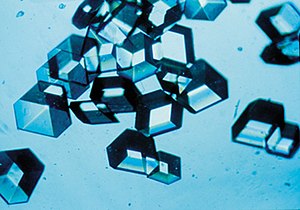
Back Vaste stof Afrikaans Festkörper ALS Solido AN ठोस ANP حالة صلبة Arabic قاسح ARY صلب ARZ কঠিন Assamese Sólidu AST Bərk cism Azerbaijani
| Part of a series on |
| Continuum mechanics |
|---|
| Condensed matter physics |
|---|
 |
This article needs additional citations for verification. (May 2017) |

Solid is one of the four fundamental states of matter along with liquid, gas, and plasma. The molecules in a solid are closely packed together and contain the least amount of kinetic energy. A solid is characterized by structural rigidity (as in rigid bodies) and resistance to a force applied to the surface. Unlike a liquid, a solid object does not flow to take on the shape of its container, nor does it expand to fill the entire available volume like a gas. The atoms in a solid are bound to each other, either in a regular geometric lattice (crystalline solids, which include metals and ordinary ice), or irregularly (an amorphous solid such as common window glass). Solids cannot be compressed with little pressure whereas gases can be compressed with little pressure because the molecules in a gas are loosely packed.
The branch of physics that deals with solids is called solid-state physics, and is the main branch of condensed matter physics (which also includes liquids). Materials science is primarily concerned with the physical and chemical properties of solids. Solid-state chemistry is especially concerned with the synthesis of novel materials, as well as the science of identification and chemical composition.
